*
Earl Cooper, auto racer, taken at the auto races at Salem, New Hampshire. Cooper’s last major victory was here at the Rockingham board track speedway. He won that 200-miler with a front-drive Miller in 1926. — Image by © Bettmann/CORBIS— Image by © Bettmann/CORBIS
*
Nebraska-born in 1886, Earl Cooper became a star just as the Golden Age of auto racing was dawning. Cooper’s illustrious racing career, in which he racked-up three National Championships (1913, 1915 & 1917) and 11 top 10 points finishes, all started in 1904– in an ironic and bittersweet twist.
It was 1904, and Cooper was on the West Coast working as a mechanic at a Maxwell auto dealership. Cooper was bitten by the racing bug, but when he appealed to the Maxwell dealership for sponsorship in a San Francisco race, he was refused. Turns-out his own boss was competing in the same race and did not welcome the friendly competition. So Cooper scoffed at the dealership’s snub, and somehow was able to convince a kind old woman to let him enter her brand new Maxwell in the race. Cooper soundly beat his boss– and just as quick, found himself unemployed. With nothing left to lose, he went on a racing tear, up and down the West Coast, where he was at times unstoppable.
Cooper joined the Stutz racing team in 1912, and just one year later went on to win the National Championship– racking up 2,610 points. Cooper dominated the scene that year, winning five of the eight major road races, along with one 2nd place finish.
*
Earl Cooper and his riding mechanic in the Stutz car. Picture taken at Indianapolis 500 qualifying in 1919. (Indianapolis Motor Speedway photo. Noel Allard collection)
*
In 1913, Cooper’s Hell-bent rival, Barney Oldfield, was driving for the Mercer team. The two battled fast and furiously, matching their skill and will on the racetrack–
Cooper and Oldfield would run head-to-head at the Santa Monica Road Race, held on an eight-mile macadam course near the ocean. Oldfield blasted away from the starter’s flag and held a sizeable lead, but Cooper passed Tetzlaff for second and began running Oldfield down. With a 4-minute lead over Oldfield, one of Cooper’s tires blew out and he had to coast into the pits. As his riding mechanic struggled to get the wheel off, Oldfield roared past. Cooper jumped out of the driver’s seat and wrenched the wheel off, the tire was changed and the car back on the track to begin running down Oldfield once more. In his exuberance to stay ahead, this time Oldfield blew a tire and bumped into the pits as Cooper whisked past and on to the checkered flag as the winner.
On September 9, 1913, Cooper and Oldfield again met head-to-head on a 3-mile paved track that circled the town of Corona, California. Cooper, after experiencing the tire problem at Santa Monica, had cannily practiced on the course to find what maximum speed he could drive in order to not make any tire stops at all. He determined that if he drove 75 mph. for the entire race, he could do just that. Oldfield, hell-bent-for-leather, predicted that the race average would go to 90 mph. Oldfield set the pace from the start, over Cooper, Tetzlaff, DePalma and Spencer Wishart. He clocked an awesome 98 mph on one lap, but the track had started to break up from the pounding it was taking from the heavy cars. Oldfield burst a tire and Cooper inherited the lead. Oldfield was back on the track and again at speed when again, a young spectator ran onto the track in front of him. Oldfield swerved to avoid the lad and crashed heavily, injuring several people and himself. Cooper won again and would go on to take his first AAA National Championship.
–Noel Allard
*
*
Earl Cooper in action at the start of a race in 1925, Laurel, Maryland.
*
1915 was another banner year, as Cooper battled back from health issues that had kept him largely sidelined in 1914. He won the first race of 1915 at Point Loma, California, then was forced to take time off from racing due to his health for the early part of the season. He scored points at Indianapolis with a 4th place finish, along with another 4th place finish at Maywood, IL, and two 2nd place finishes at Tacoma, WA. Cooper also managed 2nd in a 50-lap invitational on the Chicago board track. He followed that with a win in one of two events at Elgin, IL, and at a 500-mile race on the cement speedway at Fort Snelling, MN, outside Minneapolis. He also won three 100-mile non-points-awarding races in the West to close the season.
On May 26, 1925, Earl Cooper became the first driver to exceed 110 mph at the famed speedway in Indianapolis when he drove his Junior 8 to 110.728 mph in an official qualification lap. The record didn’t last long. He was eclipsed later in the day by Harry Hartz with a speed of 112.994 mph and again the same day by Peter DePaolo at 114.285 mph in a Duesenberg.
He also set a four-lap qualifying record at 110.487 mph in 1925, but was topped by Hartz, DePaolo and eventual pole sitter Leon Duray in a Miller at 113.196 mph.
Earl Cooper’s impressive racing career lasted until 1927. But retirement did not mean an end to racing– Cooper spent several years as a team manager. Along with his loyal mechanic over the years, Reeves Dutton, they built three front-drive Cooper racing cars, one of which competed at Indianapolis into the 1940s. Earl Cooper died on Oct. 22, 1965 in Atwater, CA, at the age of 79.
*
San Francisco, California — Photo shows auto racing legend Earl Cooper of San Francisco at the race at Rochingham. — Image by © Bettmann/CORBIS
*
*
Circa 1920s — At the auto races — Image by © H. Armstrong Roberts/CORBIS
*
*
Circa 1925– Earl Cooper standing next to his Miller race car.
*
*
Circa 1925– The starting grid. (Via)
*
*
Circa 1925– Race car driver Doc Shattuc behind the wheel of his Miller. Love the sweater / ‘stache combo.
*
*
Circa 1925– A Miller and 2 Duesenberg race cars.
*
*
Earl Devore– displaying serious 1925 motor racing rad-ness.
*
*
Circa 1925– Auto race at Laurel, Maryland.
*
*
1925– Wade Morton posing behind the wheel of his Duesenberg race car.
*
*
Ralph de Palma after crashing out spectacularly in the Earl Cooper/Ralph Hepburn Miller. The other driver is Doc Shattuc. (Via)
*
*
Laurel one year later when AAA drivers and cars were gone (they didn’t come back after an organizational hiccup). This is an NMRA (National Motor Racing Assoc.) event June 19th, 1926, a 100-miler won by Jimmy Gleason. (Via)
*
*
Circa 1925– Driver Tommy Milton next to a Miller race car.
*
*
Circa 1925– Pete de Paolo, Duesenberg – the winner at Laurel following the scoring protest.
*
*
Circa 1925– Bob McDonogh and his Miller race car.
*
*
July 1925– Jerry Wonderlich in his Miller race car at Laurel.
*
*
Circa 1925– Race car driver Bob McDonogh, post race. Coated in soil n’ oil.
*
*
July 1925– Bob McDonogh again, with his Miller race car, Laurel, Maryland.
*
*
July 1925– Pete de Paulo, declared winner at Laurel after the scoring protest.
*
To be continued…
*
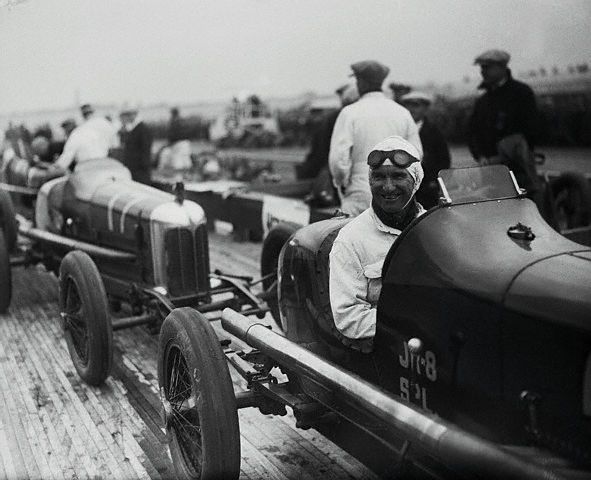

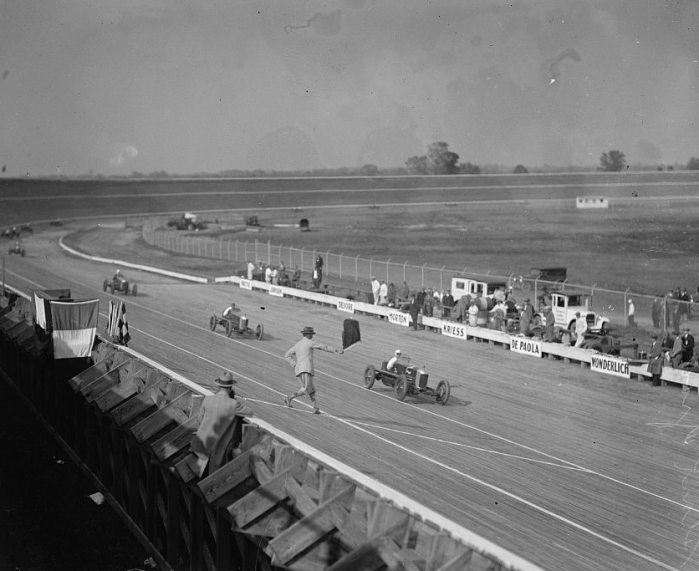


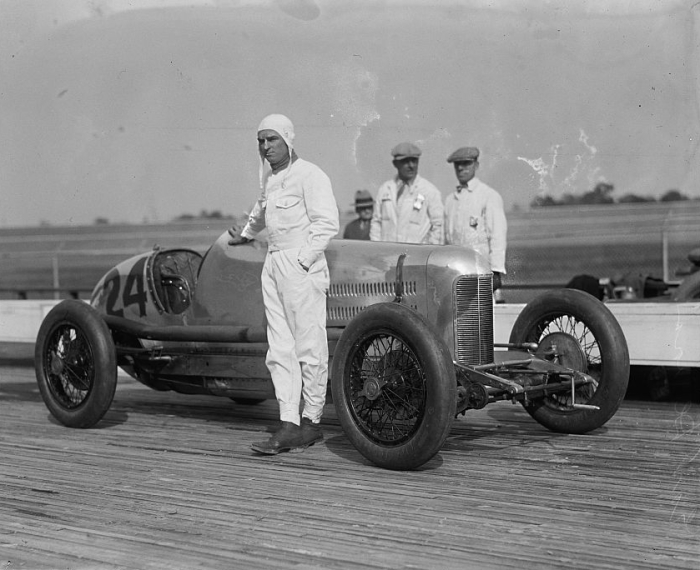






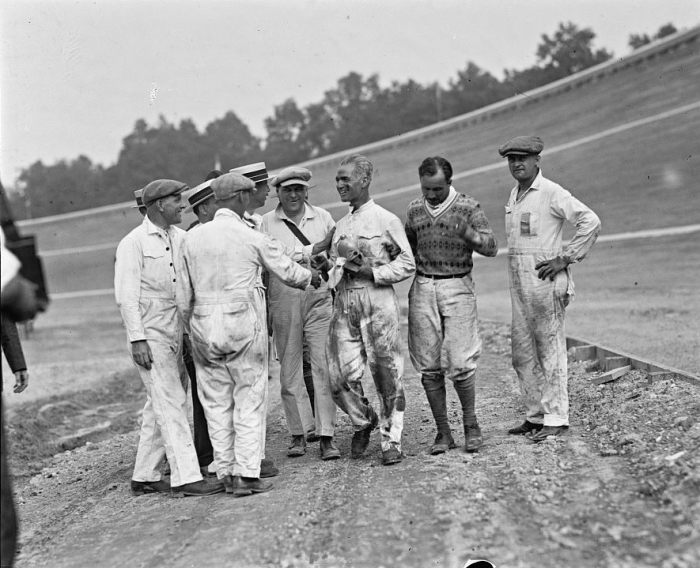
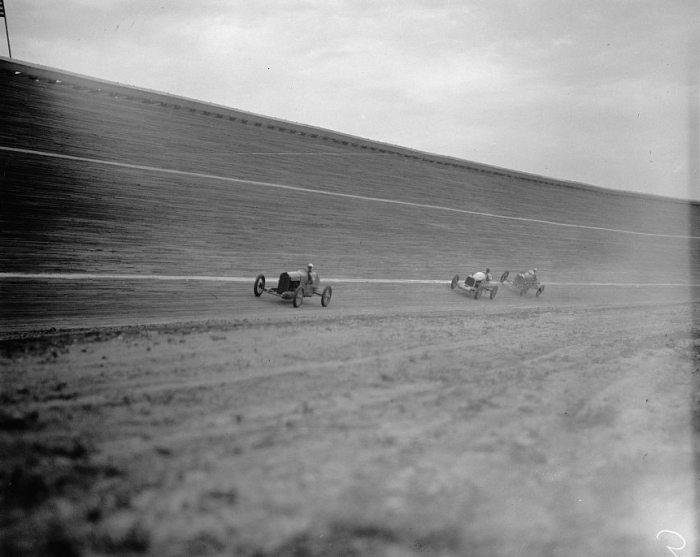





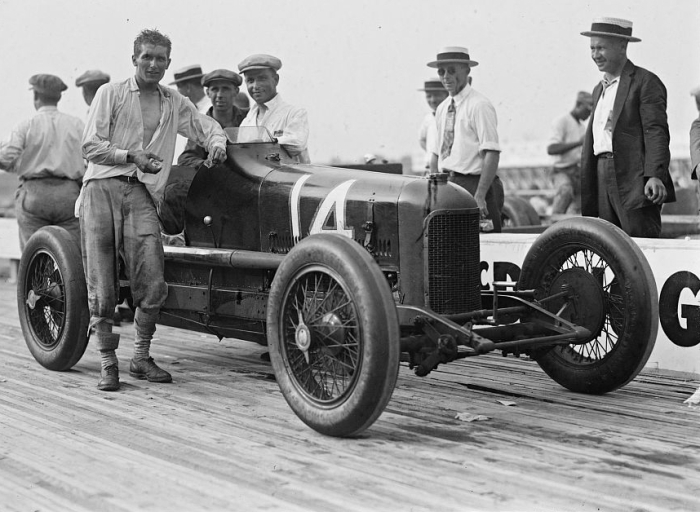

…love the photo of Ralph de Palma post crash. Talk about capturing a moment in time.
Those guys had spirit and guts for days….
so good to see the picture from the rear of the boards-we will never again witness such passion , bravery,and plain old guts as the men who raced the boards-especially the early pioneer,s on the big bikes.
those days would make a great gladiatorial movie
Incredible story and images.
i’m intrigued by the tracks planked in wood… i never knew about them.
Looks like the guy with the sweater/mustache combo was the inspiration for D-Day from Animal House.
Good call. Although he’d strangle that guy with his own sweater.